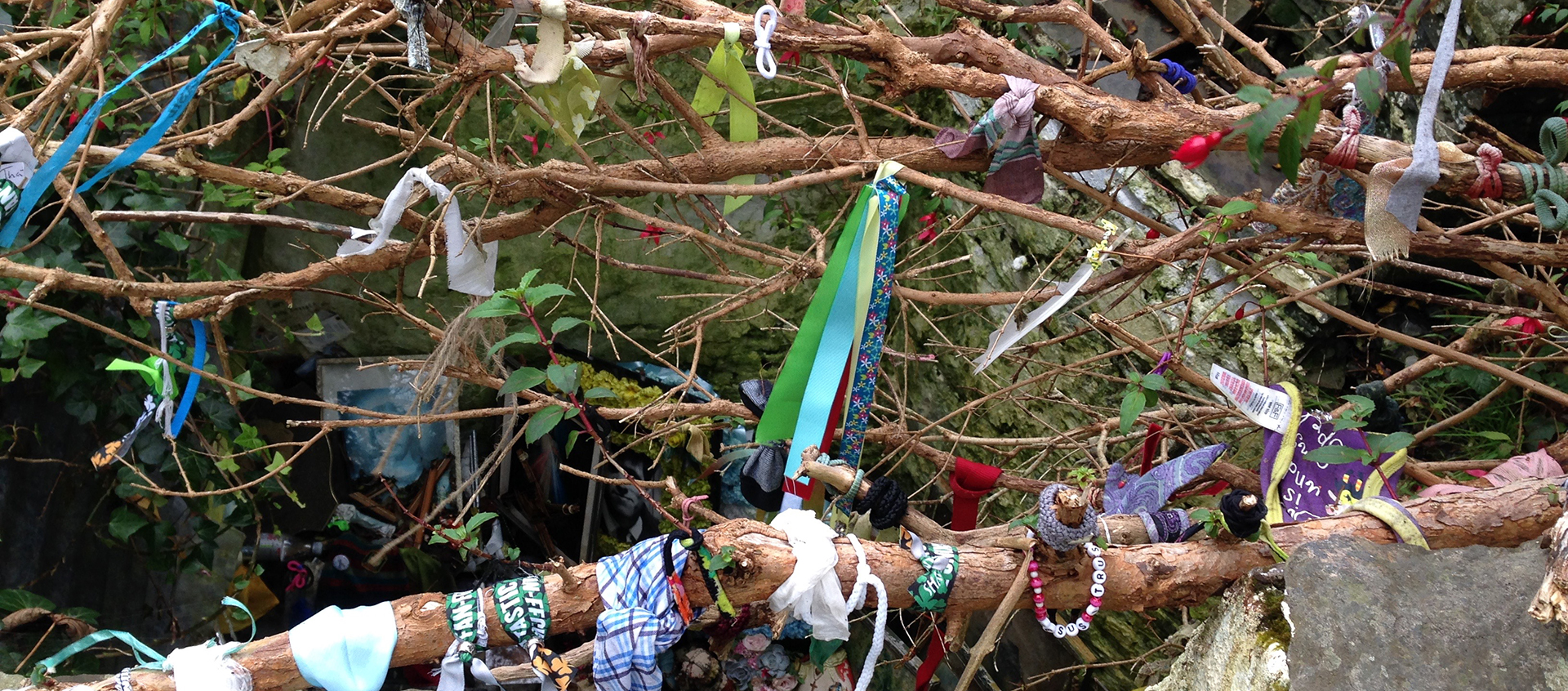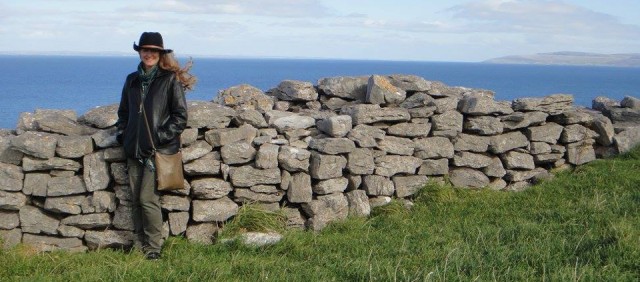Searching for Brigid, Celtic Goddess and Icon

On a mini bus in Ireland, en route to the Cliffs of Moher, our driver made an unexpected stop, lurching roadside.
“What's happening?” I asked.
“It's Brigid’s Well,” someone said. Twenty travelers peered out the windows.
I’d heard about the many wells devoted to Brigid on previous trips to Ireland. I’d pictured a modest hole, a bucket attached to a rope. You throw a coin. You take care not to topple in. But this particular Brigid’s Well was a mystical graveyard and grotto combined: headstones among trees and the sound of running water inside a small white cavern. Everywhere, visitors had left mementoes—bits of ribbon tied to branches, photos and messages tucked into crevices.

“As I enter [the grotto], it’s dark and uninviting—and cold,” wrote blogger Anonymous Pilgrim of her visit there. “There is the smell of dampness—a penitential feel. But I see the walls are dripping with prayer: petitions for the sick, expressions of thanksgiving, sorrow, grief, and hope. It has a mysterious atmosphere as the sun begins to fall low in the sky.”
Tony, our driver, said, “It’s best to visit the well between dusk and dawn, the time when the veil between the living and the dead is thin … or so the ancients believed.”
Soon we stood before the dramatic sweep of the Cliffs—electric green and blue, fierce wind and height—but Brigid stayed with me. Who was she? Google couldn’t tell me succinctly. She wasn’t easy to define.
Brigid means “exalted one,” explains Irish theologian and singer Nóirín Ní Riain, while her ancient name, Breo-Saighead, means “fiery power” or “fiery arrow.” According to Irish mythology, Brigid was born with flames shooting from her head, which connected her to the cosmos.
As a matriarchal icon, Brigid is known as the Triple Goddess for her fires of the hearth (home and healing), inspiration (poetry), and the forge (metalworking), Nóirín continued. And she’s sometimes called Goddess of the Well.
In order to appeal to “pagan” converts, the church incorporated gods and goddesses into the Christian faith in Ireland. And so goddess Brigid became Saint Brigid, who is said to have died in 525 AD in Kildare. She founded the first nunnery in Ireland, which became a monastery too. But the abbess continued to outrank the abbot.
Nóirín, who lived for 16 years in a monastery, Glenstal Abbey, knows this isn’t always the case. Though women were excluded from leading worship at Glenstal, she pursued her PhD in theology and was finally ordained in 2017 as an Interfaith Minister. As a representative of the Brigideen Nuns, she was invited to carry the flame of Saint Brigid from Ireland to the UN Women’s Convention in Beijing in 1995. In fact, her son Owen, then 16, carried it in his pocket, using a kind of hand warmer to sustain a spark.
Nóirín was at Kripalu teaching a program called The Happy Heart Is True: Celtic Wisdom and Spirituality in Song, Poetry, and Story, alongside her sons, Owen and Mícheál Moley Ó Súilleabháin. (“For these next two days, you’re at your Granny’s,” Nóirín said in Irish and then English as she greeted the group—meaning, “Make yourself at home.”)
It was February, the Celtic season of Imbolc, or Saint Brigid’s Day. Imbolc is the beginning of spring in Ireland, though it’s observed halfway between the winter solstice and the spring equinox. Feast times of the Celtic calendar are held at “the midway points, the time of thresholds, rather than the highest points of the seasons,” Nóirín explained. Much of Celtic mythology is concerned with these “in-between times,” the liminal space linking darkness and light.
Miracles occurred within these spaces, said Nóirín, some performed by Saint Brigid: She changed water into beer for the benefit of a leper colony; from one barrel flowed enough to fill 18. (She’s sometimes known as the patron saint of beer.) Next she restored the vision of Dara, a blind nun. But clear sight made it hard for Dara to pray. She asked Saint Brigid to make her blind again so that she might “return to the beauty of darkness.”
This reminds me of the “veils” Tony referred to at the well, thinnest at night. Perhaps too much light makes it hard to invoke our guides, our departed. We need the shroud in order to make them present.
“In the past, great gatherings took place at the well,” wrote Anonymous Pilgrim. “Many hundreds of people from all over County Clare and the Aran Islands covered the site in small flickering candles as they prayed.”
It’s a comfort to imagine the collective ghosts of Brigid’s Well. I think of the ribbons tied to trees there, evidence of modern pilgrims paying close attention, standing on that ground in superstition or devotion, in grief or wonder. I’d felt the imprint they’d made.
Now I see Brigid as the goddess of connection. Onto her we can project our questions and desires—and perhaps our love for beer. In the alluring Irish way of blending fantastical and corporeal, mythological and liturgical, she contains all the entities we need.
Lara Tupper, MFA, is the author of two novels, Off Island and A Thousand and One Nights, and Amphibians, a linked short story collection forthcoming in 2021.
Full Bio and Programs